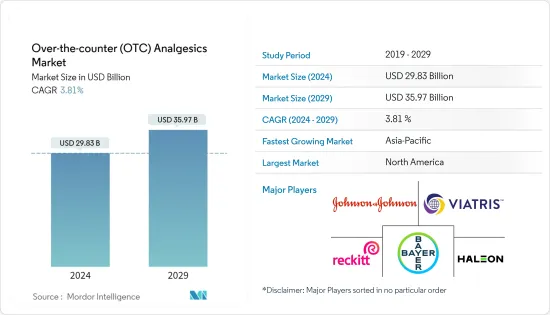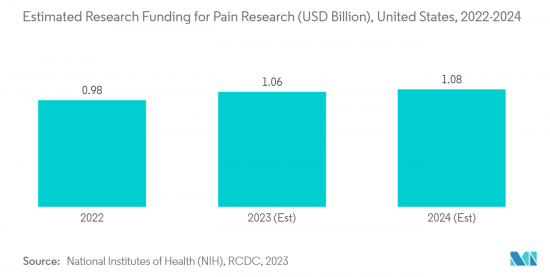
|
시장보고서
상품코드
1403896
세계 OTC(Over-The-Counter) 진통약 시장 - 점유율 분석, 산업 동향, 통계 및 성장 예측(2024-2029년)Over-the-counter (OTC) Analgesics - Market Share Analysis, Industry Trends & Statistics, Growth Forecasts 2024 - 2029 |
||||||
시판(OTC) 진통약 시장 규모는 2024년에 298억 3,000만 달러로 추정되며, 2029년에는 359억 7,000만 달러에 이를 것으로 예측되며, 예측기간 중(2024-2029년) CAGR은 3.81%에서 성장할 전망입니다.

COVID-19 팬데믹은 OTC 시장에 세계적으로 영향을 미쳤습니다. 팬데믹은 개인의 건강에 대한 관심 증가로 인해 이러한 의약품의 판매에 상당한 영향을 미치고 시장에 긍정적인 영향을 미쳤습니다. 감기약과 기침에 대한 OTC 의약품에 대한 수요는 이미 높았으며, 영양 보충제는 주로 COVID-19 팬데믹의 영향으로 더 높은 성장률이 예상되었습니다. 예를 들어, 2022년 5월에 Annals of Medicine and Surgery Journal이 발표한 논문에 따르면, COVID-19의 유행시에 가장 많이 사용된 시판(OTC) 의약품은 해열제(아세트아미노펜, 이부프로펜), 항히스타민제(세티리딘, 로라타진), 기침(덱스트로메토르판), 비타민 B, C, D, 아연 등이었습니다. 이 논문은 또한 나이지리아, 방글라데시, 페루, 토고와 같은 저소득 국가에서의 COVID-19 팬데믹병에서의 자기 투약의 유병률은 발열, 기침, 감기, 코 막힘, 피로와 같은 다양한 증상에 대해 34%에서 84%로 폭이 있어 매우 높다고 생각한 것도 보고하고 있습니다. 이와 같이 팬데믹은 OTC 진통제 수요를 급증시켰습니다. 그러나 현재 시나리오에서는 통증을 완화하거나 열을 낮추기 위해 상용(OTC) 의약품을 사용하면 예측 기간 동안 조사한 시장의 성장을 가속할 것으로 예상됩니다.
시장 성장을 뒷받침하는 주요 요인으로는 국소 진통제에 대한 수요 증가, 노인 인구 증가, 다양한 질병 유병률 상승, OTC 진통제 비용 효율 등이 있습니다. 2022년 11월에 BioMed Central(BMC) 저널에 게재된 논문에 따르면, 만성 통증은 세계의 약 20%의 사람들에게 공통된 질병입니다. 2020년 중국 통증건강지수(CPHI)가 가장 높았던 것은 베이징이었습니다. 상위 5성은 베이징시(67.64포인트), 상하이시(67.04포인트), 절강성(65.74포인트), 산동성(61.16포인트), 천진시(59.99포인트)였습니다. 이와 같이 만성 통증이 세계적으로 확대되고 있는 것을 알 수 있습니다. 그 결과, OTC 진통제 수요는 예측 기간 동안 성장할 것으로 예상됩니다.
노인들은 만성 통증을 겪기 쉽기 때문에 통증 완화 솔루션 수요는 노인 인구 증가로 증가하고 있습니다. 노인 인구의 지속적인 증가는 몇몇 노인 문제를 일으키므로 환자는 병원에 가는 것을 삼가고 집에서 약물이나 치료를 받는 것을 선호합니다. 예를 들어, 2022년 3월에 Frontiers in Human Neuroscience에 게재된 논문에서는 노인 인구의 장기 기능 장애 및 기타 만성 질환이 만성 통증으로 크게 이어질 수 있다고 보고되었습니다. 따라서 이러한 요인으로 인해 시장에서 기본 시판(OTC) 진통제 제품의 중요성이 높아지고 채용이 진행되고 있습니다. 이러한 의약품은 노인 환자 집단에 수년간 복용되어 왔기 때문에 시판(OTC) 수요는 시장에서 항상 높은 수준을 유지하고 있습니다.
또한 프랑스에서는 임산부의 셀프 메디케이션의 보급률이 높습니다. 국립생물공학정보센터(NCBI)가 2021년 1월 발표한 조사 논문에 따르면, 세계적으로 OTC 진통제의 어머니에 의한 소비는 매우 많아 급격히 증가하고 있습니다. 이처럼 셀프메디케이션의 보급률의 상승은 시장 전체의 성장을 가속할 것으로 예상됩니다.
게다가 NCBI가 2022년 11월에 발표한 다른 논문에 따르면 인도에서의 셀프메디케이션의 전체적인 평균 유병률은 53.57%였습니다. 이 출처에 따르면, 셀프메디케이션을 실천하는 주요 이유는 약에 대한 의식의 높이에 있는 것 같고, 그 실천은 중류 이하의 가정의 개인에 의해 많이 보였고, 유병률은 26.31%였습니다. 게다가 셀프메디케이션(SM)의 주요 이유는 가벼운 질병이었고, 그 중에서도 두통이 가장 많이 보고되었습니다.
따라서 국소 진통제에 대한 수요 증가, 노인 인구 증가, 다양한 질병 유병률 상승, 시판(OTC) 진통제 비용 효과 등으로 시장은 예측 기간 동안 높은 성장을 달성할 것으로 예상됩니다. 그러나 약물 내성, 의존, 중독 및 남용은 예측 기간 동안 시장 성장을 둔화시킬 것으로 예상됩니다.
시판약(OTC) 진통제 시장 동향
예측 기간 동안 비스테로이드성 항염증제(NSAIDs) 부문이 시장에서 주요 점유율을 차지할 전망
NSAIDs는 시클로옥시게나제(COX)라고 불리는 효소를 저해함으로써 통증과 염증을 억제하는 작용을 합니다. COX를 억제함으로써 NSAIDs는 통증과 염증을 예방하고 완화합니다. 일반용 의약품인 NSAIDs는 크림이나 젤 등의 외용약과 경구약이 있습니다. 그러나 정제보다 외용약이 더 안전할 수 있습니다. 비 스테로이드 성 항염증제(NSAIDs) 부문은 널리 이용 가능하고, 만성 통증과 염증 사례의 부담이 증가하고, 통증과 관리에 대한 연구 자금이 증가하고 있기 때문에 시장에서 큰 점유율을 차지할 것으로 예상됩니다.
NSAIDs는 류마티스 관절염과 척추 관절염과 같은 만성 염증성 질환의 치료에도 널리 사용됩니다. NSAIDs는 저렴하고 류마티스 관절염에 특징적인 만성 통증, 염증 및 부종을 관리하는 데 도움이되므로 다른 약물보다 선호됩니다. 따라서 이러한 염증성 질환의 높은 부담은 OTC NSAIDs 수요를 증가시키고 시장 성장을 가속할 것으로 예상됩니다. 예를 들어, 2022년 11월 미국 류마티스 학회(American College of Rheumatology)가 발표한 조사 보고서에 따르면, 카이로프랙틱 클리닉의 치료를 받고 있는 만성 요통 환자의 약 12%가 진단되지 않은 액와 척추 관절염(axSpA)를 앓고 있으며, 그 중에서도 비방사선성 axSpA가 가장 흔한 병형이었습니다. 이는 만성 요통 환자의 부담이 크고 시판(OTC) 진통제의 필요성이 증가하고 있음을 보여줍니다. 이 때문에 시장은 크게 성장할 것으로 예상됩니다.
게다가, 비스테로이드성 항염증제의 새로운 승인과 출시는 이들 제품 시장에서 가용성을 높여 시장이 크게 성장할 가능성이 높습니다. 예를 들어, 2023년 3월 Perrigo Company PLC는 여러 통증 관련 증상에 대한 아세트아미노펜과 이부프로펜 정제의 약식 신약 승인 신청(ANDA)에 대해 미국 식품의약국(FDA)으로부터 최종 승인을 받았습니다. 이러한 새로운 승인과 상시는 NSAIDs의 가용성을 높여 예측 기간 중 시장의 성장을 뒷받침할 것으로 보입니다.

북미는 예측기간 동안 크게 성장할 것으로 예상
북미는 근골격계 질환이나 스포츠 관련 상해의 유병률 증가, 증상 완화를 위한 셀프 메디케이션의 보급, OTC 의약품의 승인·출시 증가 등의 요인으로부터 시장에 큰 영향을 미칠 것으로 예상됨 합니다. 이러한 요인은 이 지역 시장 성장을 가속할 것으로 예상됩니다.
예를 들어 미국 고등학교 스포츠 관련 상해 감시 연구가 2022년 8월 발표한 보고서에 따르면 미국에서는 2021/22년도에 4,998건의 상해가 보고되며, 상해 발생률은 20경기 선수 1,000명당 상해 발생 건수는 2.02건이었습니다. 또한 남자 레슬링 경기의 상해 발생률은 2020/2021년도 1,000명당 3.2건에서 2021/22년도에는 1,000명당 5.5건으로 증가하고 있습니다. 이는 스포츠와 관련된 상해가 증가하고 있음을 나타내며, 통증 관리를 위한 OTC 진통제 수요가 증가할 것으로 예상됩니다. 이는 조사 기간 동안 시장에 큰 영향을 미칠 것으로 예상됩니다.
게다가, 규제 당국에 의한 제품 승인은 새로운 효과적인 시판 제품의 가용성을 높이고, 이는 조사 대상 시장의 성장을 가속할 것으로 예상됩니다. 예를 들어, 2022년 4월, Genexa는 사상 최초의 깨끗한 성인용 아세트아미노펜 진통제를 출시했습니다. 마찬가지로, 2022년 8월, Haleon은 캐나다인에게 신뢰할 수 있는 2개의 진통제를 편리한 1정으로 모은 Advil PLUS 아세트아미노펜을 출시했습니다. 이 제품은 캐나다 전역의 약국, 식료품점, 소매점에서 시판되고 있으며 온라인에서도 구입할 수 있습니다. 이러한 제품의 출시는 소비자 의약품 업계 전체를 활성화시키는 선진적인 접근입니다. 그 결과, 이 지역 전체에서 시장이 크게 성장할 것으로 기대됩니다.
시판약(OTC) 진통제 산업 개요
시장은 다국적 기업뿐만 아니라 현지 기업도 다수 존재하기 때문에 상당히 경쟁이 치열합니다. 이 시장에서 사업을 전개하는 기업은 보다 큰 시장 점유율을 획득하기 위해 신제품 출시, 지역 확대, 제휴, 협력 등 다양한 전략을 채용하고 있습니다. 시장의 주요 기업으로는 Bayer AG, Boehringer Ingelheim International GmbH, Johnson & Johnson, Reckitt Benckiser Group PLC, Sanofi SA, Sun Pharmaceutical Industries Ltd 등이 있습니다.
기타 혜택:
- 엑셀 형식 시장 예측(ME) 시트
- 3개월간의 애널리스트 서포트
목차
제1장 서론
- 조사의 전제조건과 시장 정의
- 조사 범위
제2장 조사 방법
제3장 주요 요약
제4장 시장 역학
- 시장 개요
- 시장 성장 촉진요인
- 국소 진통제에 대한 수요 증가
- 근골격계 질환의 유병률 증가에 수반하는 고령자 인구 증가
- OTC 진통제의 비용 효율성
- 시장 성장 억제요인
- 약물 내성, 의존, 중독, 남용
- Porter's Five Forces 분석
- 신규 참가업체의 위협
- 구매자/소비자의 협상력
- 공급기업의 협상력
- 대체품의 위협
- 경쟁 기업간 경쟁 관계의 강도
제5장 시장 세분화(시장 규모- 100만 달러)
- 의약품의 유형
- 아세트아미노펜
- 비스테로이드성 항염증제(NSAIDs)
- 살리실산염
- 기타 진통제
- 유통 경로
- 병원 약국
- 소매 약국
- 온라인 약국
- 기타 유통 채널
- 지역
- 북미
- 미국
- 캐나다
- 멕시코
- 유럽
- 독일
- 영국
- 프랑스
- 이탈리아
- 스페인
- 기타 유럽
- 아시아태평양
- 중국
- 일본
- 인도
- 호주
- 한국
- 기타 아시아태평양
- 중동 및 아프리카
- GCC 국가
- 남아프리카
- 기타 중동 및 아프리카
- 남미
- 브라질
- 아르헨티나
- 기타 남미
- 북미
제6장 경쟁 구도
- 기업 프로파일
- Bayer AG
- Boehringer Ingelheim International GmbH
- Johnson & Johnson
- Haleon PLC
- Endo International PLC
- Reckitt Benckiser Group PLC
- Sanofi SA
- Sun Pharmaceutical Industries Ltd
- Teva Pharmaceutical Industries Ltd
- Viatris Inc.
- Dr. Reddy's Laboratories Ltd
- Novartis AG
제7장 시장 기회와 앞으로의 동향
JHS 24.01.23
The Over-the-counter Analgesics Market size is estimated at USD 29.83 billion in 2024, and is expected to reach USD 35.97 billion by 2029, growing at a CAGR of 3.81% during the forecast period (2024-2029).
The COVID-19 pandemic affected the OTC market globally. The pandemic had a positive impact on the market, as it considerably influenced the sales of these drugs due to the increased focus on personal health. The demand for cold and cough OTC drugs was already high, and dietary supplements were expected to have a higher growth rate, mainly due to the COVID-19 pandemic. For instance, an article published by the Annals of Medicine and Surgery Journal in May 2022 reported that the most common OTC drugs used during the COVID-19 pandemic were antipyretics (acetaminophen, ibuprofen), antihistamines (cetirizine, loratadine), a cough suppressant (dextromethorphan), vitamins B, C, D, zinc, etc. The article also reported that the prevalence of self-medication during the COVID-19 pandemic in lower-income countries like Nigeria, Bangladesh, Peru, and Togo varied from 34% to 84% for various symptoms like fever, cough, cold, nasal congestion, and fatigue, which was considered very high. Thus, the pandemic surged the demand for OTC analgesics. However, in the current scenario, the use of OTC drugs for relieving pain or lowering a fever is expected to drive the growth of the market studied over the forecast period.
The major factors boosting the growth of the market include the increasing demand for topical analgesics, the growth of the geriatric population, the rising prevalence of various diseases, and the cost-efficiency of OTC analgesic drugs. An article published in the BioMed Central (BMC) Journal in November 2022 reported that chronic pain is a common disease for about 20% of people worldwide. The highest China Pain Health Index (CPHI) in 2020 was in Beijing. The top five provinces were Beijing (67.64 points), Shanghai (67.04 points), Zhejiang (65.74 points), Shandong (61.16 points), and Tianjin (59.99 points). Thus, such instances show that chronic pain is growing globally. As a result, the demand for OTC analgesics is expected to grow over the forecast period.
The demand for pain relief solutions is increasing due to the growing elderly population, as aged people are more prone to chronic pain. The continuous growth of the geriatric population leads to several old age problems, for which patients refrain from going to hospitals and prefer to get medications and treatment at home. For instance, an article published by Frontiers in Human Neuroscience in March 2022 reported that organ dysfunction and other chronic diseases in the geraitric population could significantly lead to chronic pain. Thus, such factors lead to the growing importance and adoption of basic analgesic OTC products in the market. These drugs have been taken for years by the elderly patient population, which keeps the OTC demand consistently high in the market.
Additionally, there is a high prevalence of self-medication among pregnant women in France. According to the research article published by the National Center for Biotechnology Information (NCBI) in January 2021, there is a very high prevalence of maternal consumption of OTC analgesics globally, which is increasing sharply. Thus, the rising prevalence of self-medication is expected to propel the overall market growth.
In addition, another article published by NCBI in November 2022 reported that the overall mean prevalence of self-medication practices in India was 53.57%. The same source stated that the awareness of the medication seems to be a major reason to practice self-medication, and the practice was noticed more among individuals from middle-lower class families, with a prevalence rate of 26.31%. Furthermore, minor ailments were the primary reason for self-medication (SM), among which headache was the most commonly reported.
Thus, due to the increasing demand for topical analgesics, the growth of the geriatric population, the rising prevalence of various diseases, and the cost efficiency of OTC analgesic drugs, the market is expected to witness high growth over the forecast period. However, drug tolerance, dependence, addiction, and abuse are expected to slow down the growth of the market over the forecast period.
Over-the-counter (OTC) Analgesics Market Trends
Nonsteroidal Anti-inflammatory Drugs (NSAIDs) Segment is Expected to Have the Major Share in the Market over the Forecast Period
NSAIDs work to reduce pain and inflammation by inhibiting enzymes called cyclooxygenases (COX). By inhibiting COX, NSAIDs help prevent and/or reduce pain and inflammation. OTC NSAIDs are available as creams and gels for topical use, and a few are available as oral formulations. However, topical use may be safer than the pill form. The NSAIDs segment is expected to have a significant share in the market due to its widespread availability, the rising burden of chronic pain and inflammation cases, and increasing research funding for pain and its management.
NSAIDs are also used broadly for the treatment of chronic inflammatory disorders such as rheumatoid arthritis and spondyloarthritis. They are preferred over other drugs because they are inexpensive, and they help manage chronic pain, inflammation, and swelling that are characteristic of rheumatoid arthritis. Hence, the high burden of these inflammatory diseases increases the demand for OTC NSAIDs, which is anticipated to propel the market's growth. For instance, according to the study report published by the American College of Rheumatology in November 2022, approximately 12% of patients with chronic back pain in the care of chiropractic clinics had undiagnosed axial spondyloarthritis (axSpA), in which non-radiographic axSpA was the most common form of the disease. This shows the high burden of patients with chronic back pain, which increases the need for OTC analgesics. This is expected to have significant growth in the market.
Furthermore, the new approvals and launches of NSAIDs increase the availability of these products in the market, which is likely to haave significant growth in the market. For instance, in March 2023, Perrigo Company PLC received the final approval from the United States Food and Drug Administration (FDA) for its Abbreviated New Drug Application (ANDA) for acetaminophen and ibuprofen tablets for multiple pain-related symptoms. These kinds of new approvals and launches increase the availability of NSAIDs, which is expected to boost the market's growth over the forecast period.

North America is Expected to Witness Significant Growth over the Forecast Period
North America is expected to have a significant impact on the market owing to factors such growing prevalence of musculoskeletal diseases and sports-related injuries, coupled with the adoption of self-medication to relieve the symptoms and an increase in approval and launch of OTC drugs. These factors are expected to drive the growth of the market in the region.
For instance, according to the report published by the National High School Sports-Related Injury Surveillance Study in August 2022, 4,998 injuries were reported in the academic year 2021/22 in the United States, with an injury incidence of 2.02 injuries per 1,000 athletes exposures in 20 sports. In addition, there was an increase in the rate of boys' wrestling competition injuries from 3.2 per 1,000 athlete exposures in 2020/2021 to 5.5 per 1,000 athlete exposures in the 2021/22 academic year. This shows the increasing number of sport-related injuries, which is likely to increase the demand for OTC analgesics for pain management. This is expected to have a significant impact on the market over the study period.
Furthermore, product approvals by the regulatory authority increase the availability of new and effective OTC products, which is expected to drive the growth of the market studied. For instance, in April 2022, Genexa launched the first-ever clean acetaminophen pain relief product for adults. Similarly, in August 2022, Haleon introduced Advil PLUS acetaminophen to Canadians, combining two trusted pain relievers into one convenient tablet. It is available over the counter at pharmacies, grocery stores, and retailers across Canada and online. These product launches offer a forward-thinking approach that catalyzes the entire consumer pharmaceutical industry. This is expected to result in significant growth of the market throughout the region.
Over-the-counter (OTC) Analgesics Industry Overview
The market is fairly competitive due to the presence of a large number of multinational as well as local market players. Companies operating in the market are adopting various strategies, such as new product launches, regional expansion, partnerships, and collaborations, to gain larger market shares. Some of the key players in the market are Bayer AG, Boehringer Ingelheim International GmbH, Johnson & Johnson, Reckitt Benckiser Group PLC, Sanofi SA, and Sun Pharmaceutical Industries Ltd, among others.
Additional Benefits:
- The market estimate (ME) sheet in Excel format
- 3 months of analyst support
TABLE OF CONTENTS
1 INTRODUCTION
- 1.1 Study Assumptions and Market Definition
- 1.2 Scope of the Study
2 RESEARCH METHODOLOGY
3 EXECUTIVE SUMMARY
4 MARKET DYNAMICS
- 4.1 Market Overview
- 4.2 Market Drivers
- 4.2.1 Increasing Demand for Topical Analgesics
- 4.2.2 Growing Geriatric Population along with Increasing Prevalence of Musculoskeletal Diseases
- 4.2.3 Cost Efficiency of OTC Analgesic Drugs
- 4.3 Market Restraints
- 4.3.1 Drug Tolerance, Dependence, Addiction, and Abuse
- 4.4 Porter's Five Forces Analysis
- 4.4.1 Threat of New Entrants
- 4.4.2 Bargaining Power of Buyers/Consumers
- 4.4.3 Bargaining Power of Suppliers
- 4.4.4 Threat of Substitute Products
- 4.4.5 Intensity of Competitive Rivalry
5 MARKET SEGMENTATION (Market Size by Value - USD million)
- 5.1 Type of Drug
- 5.1.1 Acetaminophen
- 5.1.2 Nonsteroidal Anti-inflammatory Drugs (NSAIDs)
- 5.1.3 Salicylates
- 5.1.4 Other Analgesics
- 5.2 Distribution Channel
- 5.2.1 Hospital Pharmacies
- 5.2.2 Retail Pharmacies
- 5.2.3 Online Pharmacies
- 5.2.4 Other Distribution Channels
- 5.3 Geography
- 5.3.1 North America
- 5.3.1.1 United States
- 5.3.1.2 Canada
- 5.3.1.3 Mexico
- 5.3.2 Europe
- 5.3.2.1 Germany
- 5.3.2.2 United Kingdom
- 5.3.2.3 France
- 5.3.2.4 Italy
- 5.3.2.5 Spain
- 5.3.2.6 Rest of Europe
- 5.3.3 Asia-Pacific
- 5.3.3.1 China
- 5.3.3.2 Japan
- 5.3.3.3 India
- 5.3.3.4 Australia
- 5.3.3.5 South Korea
- 5.3.3.6 Rest of Asia-Pacific
- 5.3.4 Middle East and Africa
- 5.3.4.1 GCC
- 5.3.4.2 South Africa
- 5.3.4.3 Rest of Middle East and Africa
- 5.3.5 South America
- 5.3.5.1 Brazil
- 5.3.5.2 Argentina
- 5.3.5.3 Rest of South America
- 5.3.1 North America
6 COMPETITIVE LANDSCAPE
- 6.1 Company Profiles
- 6.1.1 Bayer AG
- 6.1.2 Boehringer Ingelheim International GmbH
- 6.1.3 Johnson & Johnson
- 6.1.4 Haleon PLC
- 6.1.5 Endo International PLC
- 6.1.6 Reckitt Benckiser Group PLC
- 6.1.7 Sanofi SA
- 6.1.8 Sun Pharmaceutical Industries Ltd
- 6.1.9 Teva Pharmaceutical Industries Ltd
- 6.1.10 Viatris Inc.
- 6.1.11 Dr. Reddy's Laboratories Ltd
- 6.1.12 Novartis AG

















